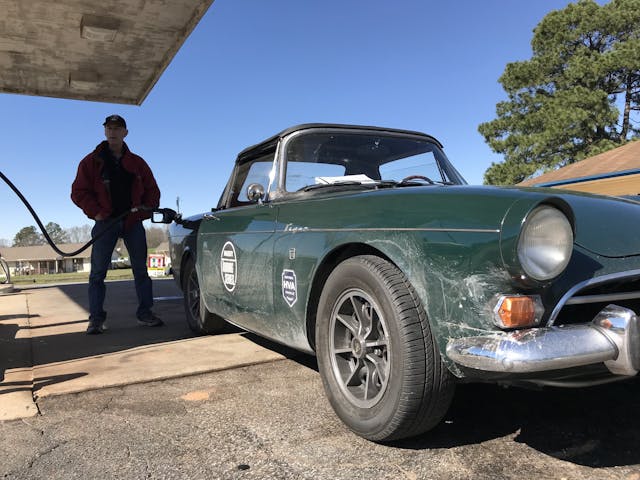7 numbers you should know about your car
Cars are utility objects first. They serve to allow us easier movement over great distances. The inherent mechanical intricacy and unique experience of driving caused users to morph into enthusiasts. Those folks dedicated to the joy of driving and maintaining these automobiles can obsess over so many small parts and details of their machines. Even the casual enthusiast knows a few little details of their car that they enjoy conversing about.
Those details can be quite banal, or very much intriguing. It really depends on how deep your knowledge of the automobile and its history is. To cover the basics:
Minimum octane rating

Engines are surprisingly durable, but also require particular care and feeding. The minimum octane rating refers to the proper fuel that the engine is tuned to run on. Most fuel stations have options for 87, 89, 91, or 93 octane, with each number referring to the fuel blends resistance to detonation as it is compressed in the combustion chamber of an engine. The higher the better right?
Wrong. Engines are tuned for certain octane ratings and putting high octane in something that does not need it will not give you more power or a cleaner engine. In fact, it’s possible the engine will run worse, and it will certainly cost you more at the pump. There is a balance though. If you put lower octane fuel than required it will certainly yield less power and can even lead to damage as the fuel can ignite before the spark plug fires, which can damage the piston, connecting rod, or cylinder head as the still-rising piston attempts to compress the expanding fuel and air mixture. Not good. We go through the effort to use the proper oil for the engine, so make sure you are using the proper fuel too.
Fuel range (ballpark)
On a long enough timeline everything fails, including your gas gauge or sending unit. When the needle stays at full or just drops like a stone to zero, do you know you can make it home? Knowing the ballpark range your car can travel on a full tank of gas is a good thing to know if you drive your vintage car regularly. Having non-working gauges is embarrassing, but running out of gas is even more so.
Start by doing a quick miles-per-gallon calculation by filling your fuel tank, driving for a weekend, then topping off and dividing the miles you covered by the number of gallons required to re-fill the tank. That can be the basis of calculating range using the fuel tank size and ballpark MPG. Be sure to leave some wiggle room in the final fuel range for conditions to change.
Horsepower

Opening the hood of a car is often like rubbing a genie lamp: Someone will always appear, but instead of giving you wishes they will pepper you with questions. The most popular one you should expect to hear? “How much power does this thing make?”
It can be both an easy and a hard question to answer. You could go by the original rating from promotional materials, or look for similar builds that have been tested on a dynamometer, or if your engine is unique enough it would probably be fun to strap it down on the rollers and find out the exact power, along with just how well tuned the package is.
Ballpark value
We know you aren’t planning on selling your car. Money talks sometimes though, and your author has experienced at least one situation where a person approached while out and about and made an offer to buy the motorcycle that got me there. It was a real offer and if I hadn’t known what the bike was actually worth I probably would have taken it. Values change over time and can sometimes move quite quickly. Be sure to know what you are driving and treat it appropriately. You might have bought it for $1500, but that was 1988 and things are different now. Luckily, finding your car’s value has never been easier.
Vehicle identification number

It sounds funny, but having the main identifying information for your car is important. Not only in case of theft, but also in case you need to find information about the history of your baby. This one doesn’t need to live in your head, but keep an old insurance ID card in a file at home even if you sell the car. People go looking for the car from their past all the time and with the VIN you stand a chance, without that bit of information it can be close to impossible to find a car from 20 years ago.
Generation years of your model

The total production run is a fun fact that is easy to pepper into a conversation about a car that can often elevate someone’s perception of you nearly instantly. People will often walk up and make a guess as to the year of a car and in our experience, it can sometimes be a little rough. “Is that a ’64?” “No, it’s a 1960, but the body is the same so it’s tough to tell” is a lot nicer way to tell someone they are wrong and start a conversation on the right foot than just saying “no.” Total production is a fun one to add to this conversation if you happen to have a steel trap memory and can keep track of something like that.
Normal oil pressure

Just like people, every engine is unique and that includes how much oil pressure it makes while running. Oil is the lifeblood of an engine and knowing that there is the proper amount circulating is peace of mind worth having. We admit most cars don’t have an oil pressure gauge with hard and fast numbers, but installing one is never a bad idea as it can alert you to something being wrong in your engine before it turns into catastrophe. Keep an eye on those gauges and shut the engine down quickly if something looks wrong. Better safe than sorry.
Check out the Hagerty Media homepage so you don’t miss a single story, or better yet, bookmark it.



I had a 1964 TR-4 that had a REAL oil pressure gauge. It consisted of some plastic pressure tubing directly from a fitting on the engine to the back of the gauge on the dashboard (Smith brand, as I recall). No sensor, no electrical connection. What you saw on the gauge was what you had in the engine. If it wasn’t leaking oil on your carpeting, that is.
I had one of those in an Econoline once, only the tubing was copper. Worked really well.
I think there are some basics you should know too. Those are: Mileage, tire pressure and odometer reading.
As many commenters have said there is no “absolute” number for oil pressure. The important thing to be watched for is changes in oil pressure. Any engine will have a “normal” range. Changes in oil pressure from this “normal” range – decrease or increase – indicates something is changing in the engine that should be addressed before no oil pressure (maybe as little on a cold winters day as letting the engine warm cold, thick oil until it thins enough to be pumped to the far corners of the engine) leaves you stranded with a dead engine.
I learned firsthand that higher octane does not mean better performance. My first car was a 1963 Pontiac Tempest with the base 194 CID 4 cylinder and 2-speed automatic. Living practically next to a Getty station I used Getty gasoline. Then Getty discontinued its “regular” grade gasoline – selling only its 103+ octane premium. Great for the big V8s of the era, but terrible for a little 4 cylinder – even one that was derived directly from one of those V8s. The loss of power was spectacular, and I was forced to change brands to feed my little wagon the low octane fuel it demanded.
The big problem with “octane” is the multitude of rating systems. The 4 prominent being “Research”, “Motor”, aviation “Lean” and aviation “Rich”, all of which yield different values for “octane”. Prior to circa 1974 and the mandate of unleaded gasoline, automotive gasoline was rated by the “Research” methodology. After 1974 gasoline has been rated by the “R+M divided by 2” methodology (sum of “Research” octane plus “Motor” octane, the sum divided by 2), which resulted in an immediate decrease in the advertised octane rating on the pump. While adding 3 or 4 to the “R+M divided by 2” octane rating may put you in the ballpark of the “Research” octane rating, and aviation “Lean” is close to the “Motor” octane rating, there is no absolute or accurate means of converting from one system to another. And so, as 2 or 3 points can be the difference between maximum power and engine destroying detonation, we are our own “test pilots” every time we refuel from a new source.
In regard to the accuracy of your oil pressure gauge: I operated a nuclear power plant for years and ‘Safety Related’ (important to operation and protection of the reactor) gauges/meters were accurate to within 1% of scale. Non safety related instrumentation was 3% of scale (so + or – 1.5 psi for a 50 psi meter). In the pecking order of equipment you have nuclear grade, then aviation grade, then commercial/industrial grade. Somewhere below that is what you buy to stick under your dash. It’s helpful for monitoring trends and consistency but may be inaccurate for comparing what your hot rod has for oil pressure vs your buddy’s.
Whenever I buy a vehicle I test grades of gasoline. When the tank is very low, I add 10 gallons and reset rhe trip odometer. Records are kept in a small spiral notebook. My ’09 Chevy 3500 crew dually and my ’16 Honda Pilot both got their best $/mile with non ethanol premium. So do my BIL’s Ford pickup and car.
Can some one definitively explain why using too high octane can hurt an engine? I understand its a waste of money but how can too high octane hurt an engine?
135hp
132 ft/lbs torque
1972 Datsun 1200
She’s a rocket ship boys.
How about proper type and weight of motor oil and tire pressure(s)?
Add to that the crankcase capacity and plate number.
Octane requirement depends on the static and dynamic ignition curves, compression ratio and whether the motor has a closed loop knock sensor / ignition timing management system. That is why some modern vehicles get better mileage on high octane. Also, Ethanol content raises octane but reduces energy content of the fuel blend, so literally speaking your mileage may vary.
If you add a mechanical oil pressure gauge to your car, be careful how you route the line. Mine shifted and laid on the header, instant smoke and a mess. Later the same gauge started filling with oil, the gauge just went black, kind of funny until it dripped on my leg.
Ammeters to me seem like a painted-on line; they never seem to move. I have added one of those usb outlets with a voltage display to a couple of my cars (in place of one of the lighters). They are great for seeing if you are dropping voltage if your alternator dies.
Knowing the real empty point in your tank is useful. My 79 ford truck was sold to me with a warning that when on empty it really was on empty. The PO probably laughed as I left; it ran out on me at 1/8 tank once (and only once).
I had one of the oil pres gauges that had the tube connector, but I think it was the gauge itself that had a defect, there was always a small amount of oil that collected slowly and sat on the bottom. I don’t know why but after a while it just seemed to stop filling the gauge. But I did get rid of it before the oil leaked into the dash
Best Pic of a Tiger I’ve ever seen!
Another comment about HP. My car was rated at 88 HP by the factory. However, that was 61 years ago and the factory rating was at the flywheel. In 1972 it was decided that HP should be rated at the rear wheels. My 88 HP at the flywheel became 74 HP at the rear wheel. When I am asked what the HP is for my Porsche and I tell them ii is 74, their mouths usually drop in disbelief. I then refrain from telling them that the base engine that year had 59 HP. This just supports the statement that HP rating is basically irrelevant. It was determined using different protocols through the years. My son-in-law’s 1972 Pontiac Le Mans Sport lost a ton of HP from the previous year with no changes to the engine.
I had a 1972 454 Chevelle with the lowered HP ratings. I don’t recall specifically but it was in the 170 or so range if my memory is half right. Not surprisingly, that 170 hp would spin the tires with no issue
I hope they secured that blue car to the dyno properly, it looks like a beast!
I didn’t manage to snap any photos when it was fully strapped down, but did get a photo of the final results: https://www.hagerty.com/media/archived/this-is-what-happens-when-you-put-a-1927-buick-on-a-dyno/
Ah, VIN Numbers! They are great if you have a car built sometime after 1960 or so, but before that time cars could be identified by either their chassis number and/or their engine serial numbers, among other parts stamped with codes. Try to find the vehicle ID number of a 1930s – 1950’s Porsche, MG, Triumph, Sunbeam, Ford, Fiat or any number of other makes. Thank the digital gods for the Internet as the info is out there somewhere. But you have a classic restored with main parts from other non-restorable classics, you may find you’ll have to get your state to issue an entirely new VIN just fr your reconstructed classic.
I remember watching Highway Patrol, they always identified the cars with a “motor number”.
Well, I have no gauges – only idiot lights, so that’s a non-issue. The engine short block is a 1967 inline six; probably from a Falcon. The head is from a 1974 Maverick. Ford claimed 116 horsepower from the engine, but that’s with a one-barrel carb. I’ve got a Weber progressive two-barrel on it, so who knows. It runs on any gasoline available. It does fine with an alcohol blend, which is fortunate, since that’s all that’s all one can buy here in New Jersey.